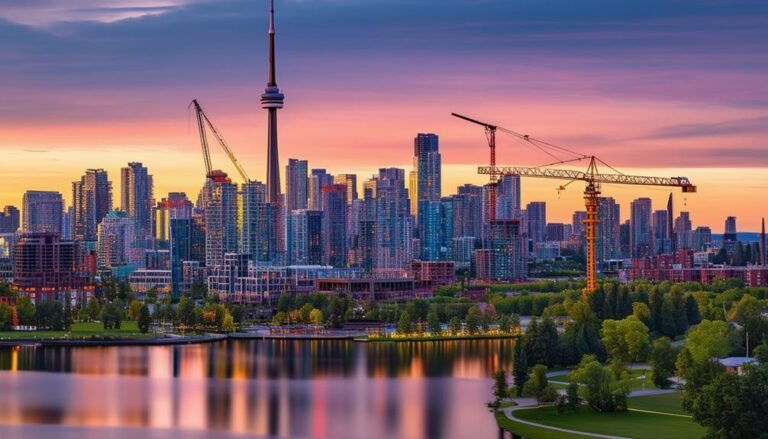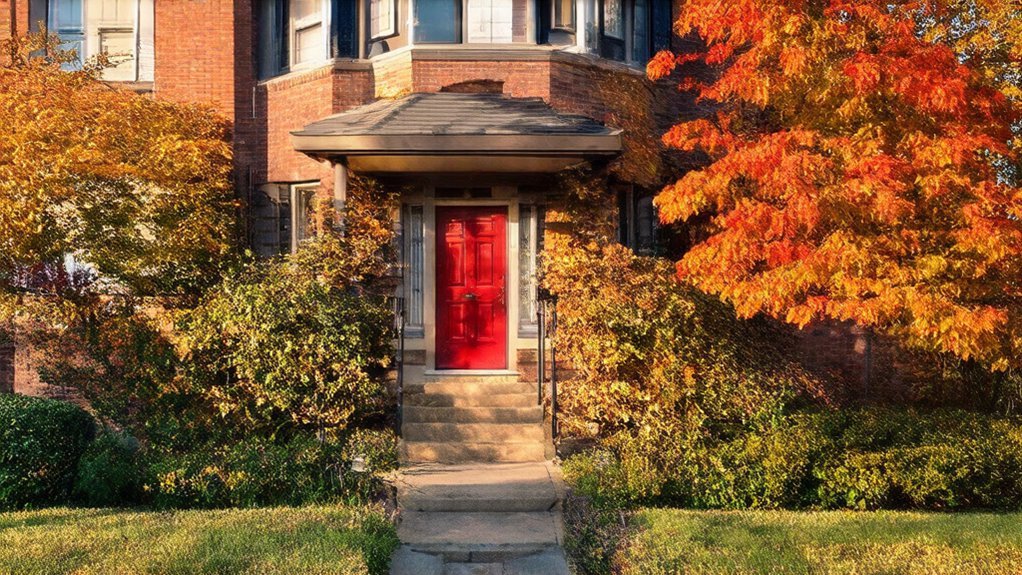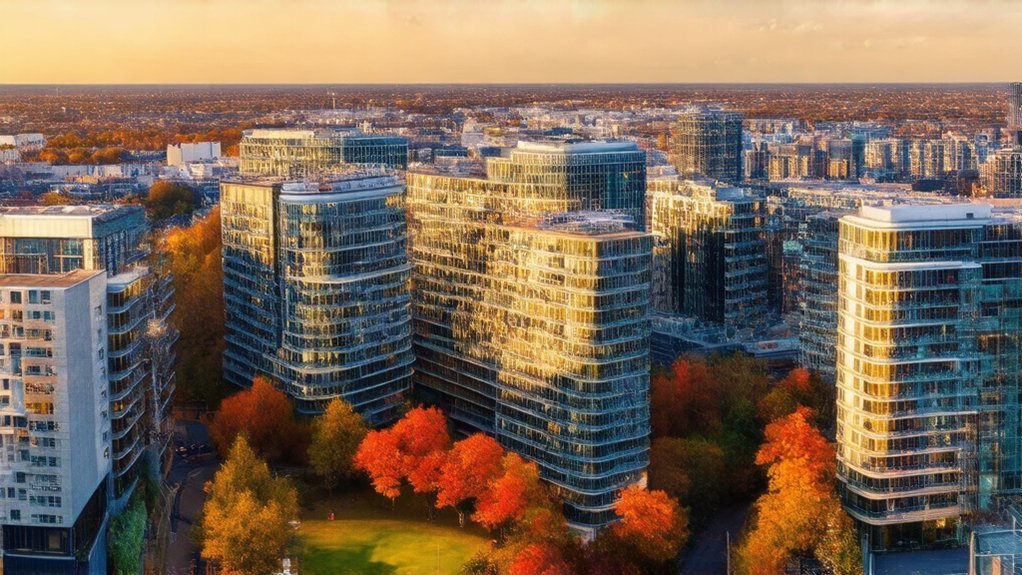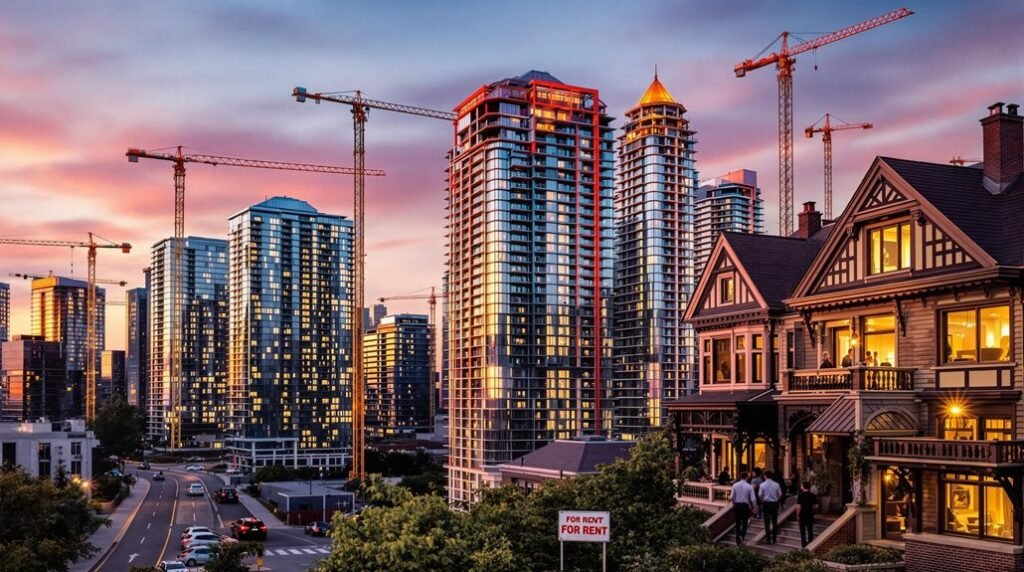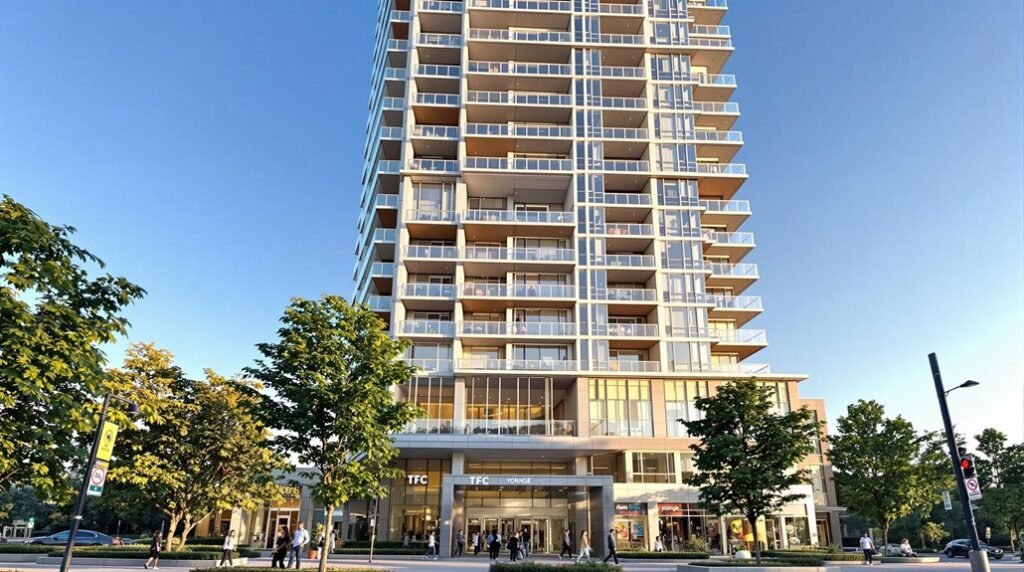Toronto’s recent real estate policies and voting decisions have had a significant impact on the housing market. The city’s ambitious ‘More Homes Built Faster‘ plan aims to create 1.5 million new homes by 2031, while Bill 23 seeks to streamline development processes. However, these initiatives face challenges, including affordability concerns and community preservation issues. The market is experiencing inventory shortages and increased competition among buyers, with government fees accounting for a substantial portion of home prices. While efforts are being made to boost affordable housing, the loss of existing units remains a concern. As Toronto grapples with these complex issues, the future of its real estate landscape hangs in the balance.
Key Takeaways
- Bill 23 aims to expedite development processes, potentially increasing housing supply but raising concerns about affordable housing.
- Toronto’s HousingTO 2020-2030 Action Plan targets 40,000 affordable rentals and 4,000 ownership homes by 2030.
- Municipal decisions significantly impact housing supply and affordability, influencing development costs and timelines.
- Ontario’s ‘More Homes Built Faster’ plan targets 1.5 million new homes by 2031, focusing on streamlining bureaucratic processes.
Key Policy Changes
In recent years, I’ve seen Toronto’s real estate landscape dramatically reshaped by a series of key policy changes aimed at addressing the city’s housing crisis. It’s been quite a ride, let me tell you! The Ontario government has rolled out its ambitious “More Homes Built Faster” plan, which is like a turbo boost for housing construction. They’re aiming to build a whopping 1.5 million new homes by 2031 – that’s more homes than there are people in Ottawa!
To make this happen, they’ve introduced Bill 23, which is designed to cut through red tape faster than a hot knife through butter. It’s meant to speed up development, but it’s not without controversy. Some worry it might accidentally trip up affordable housing efforts – oops!
Meanwhile, Toronto itself isn’t sitting on its hands. The city’s pushing for:
- 40,000 new affordable rental units
All by 2030! It’s like they’re trying to build a small city within the city.
But here’s the kicker – those pesky development fees. Did you know they make up nearly a quarter of a home’s price? That’s like paying for an extra bedroom you can’t even use!
The feds are jumping in too, with:
- The Housing Accelerator Fund
It’s like everyone’s playing a giant game of “Sim City,” trying to balance growth, affordability, and those ever-increasing immigration rates. Will these policies be the cheat code Toronto needs to win the housing game? Only time will tell!
Market Trends and Shifts

Despite economic headwinds, Toronto’s housing market‘s showing surprising resilience, with average home prices continuing their upward march. It’s like the little engine that could, chugging along despite the steep hill of high interest rates and inflation. I’m seeing a few key trends that are shaping the market:
- Inventory shortages: There’s a real squeeze on available homes, leading to some fierce competition among buyers. It’s like a game of musical chairs, but with houses!
- Construction boom: The Canadian Mortgage and Housing Corporation reports a healthy pipeline of residential projects. Builders are busy bees, but they’re not overdoing it – no housing glut expected by 2027.
However, it’s not all smooth sailing. High borrowing costs and taxes are putting the brakes on new projects. This could lead to a housing shortage down the road, just as the economy starts to pick up again. It’s a bit like planting too few seeds in spring and ending up with a sparse harvest in fall.
Affordability Challenges
Toronto’s housing affordability crisis is a multi-headed monster, with sky-high prices, limited supply, and hefty government fees all taking a bite out of buyers’ wallets. Let’s dive into the numbers, shall we? A whopping 24% of a home’s purchase price goes straight to government-imposed fees. That’s like buying a car and finding out a quarter of the cost is just for paperwork!
But here’s the kicker: while we’re struggling to create affordable housing, we’re losing it even faster. For every shiny new affordable unit that pops up, we’re waving goodbye to 15 existing ones. It’s like trying to fill a leaky bucket – we’re pouring in water, but it’s draining out faster than we can keep up.
Now, don’t get me wrong, the government’s trying to help. They’ve introduced Bill 23 to speed up housing development. But it’s a bit of a double-edged sword, with some folks worrying it might actually hurt affordable housing efforts. Talk about unintended consequences!
The good news? Torontonians are on board with boosting housing supply. A solid 71% think it should be a top priority for solving our affordability woes. And in Toronto-St. Pauls, where 60% of households are renters, the need for affordable options is crystal clear.
So, what’s the solution? Well, it’s not simple, but here are a few key points:
- Cut down on those government fees
- Protect existing affordable units
It’s a tricky balance, but with some smart policies and a little elbow grease, we might just tame this affordability monster yet!
Urban Development Strategies
While affordability challenges loom large, let’s shift our focus to the urban development strategies Toronto’s employing to tackle its housing crisis head-on. The city’s HousingTO 2020-2030 Action Plan is like a blueprint for building a more inclusive city, aiming to approve a whopping 40,000 affordable rental homes and 4,000 ownership homes by 2030. It’s as if Toronto’s trying to build its way out of the housing crunch!
But Toronto’s not alone in this construction frenzy. Ontario’s More Homes Built Faster plan is taking things to the next level, targeting 1.5 million new homes by 2031. That’s like building a whole new city within our province! To make this happen, they’re streamlining development processes, cutting through red tape faster than a hot knife through butter.
However, it’s not all smooth sailing. Bill 23, while aiming to speed up housing development, has faced some choppy waters. Critics worry it might accidentally sink affordable housing and community preservation efforts. It’s a classic case of “you win some, you lose some.”
Here’s the kicker: municipal decisions play a huge role in housing supply. Did you know that government-imposed fees make up nearly a quarter of a home’s purchase price? That’s like paying for three bedrooms but only getting two and a half!
- Streamlining development processes
- Targeting ambitious housing goals
- Balancing speed with community needs
In the end, it’s a delicate balancing act. For every step forward in creating new affordable units, we’re losing about 15 existing ones. It’s like trying to fill a leaky bucket – we’ve got to plug the holes while we’re pouring in more water!
Economic and Demographic Factors
Diving into the economic and demographic factors shaping Toronto’s real estate landscape, we’re confronted with a complex interplay of population growth, diverse housing needs, and shifting market dynamics. Let’s break it down:
Toronto’s booming population is a major driver of its real estate market. With 3 million people in the city proper and 6.5 million in the metro area, it’s like trying to fit a growing family into a house that isn’t getting any bigger! This urban density creates intense demand for housing.
Here’s the kicker: 60% of households in Toronto-St. Pauls are renters. That’s a lot of people looking for affordable places to live! It’s like a giant game of musical chairs, but with apartments instead of seats.
Toronto’s economy is like a well-balanced diet, with diverse sectors such as:
- Financial services
- Tech industry
These industries attract international immigrants, further fueling housing demand. It’s a bit of a catch-22: economic growth brings more people, which creates more housing needs, which then supports more growth.
Recent immigration policies are trying to address this by focusing on bringing in workers for the construction industry. It’s like killing two birds with one stone – more workers to build houses and more people to live in them!
But here’s the plot twist: high borrowing costs and inflation are throwing a wrench in the works. They’re expected to impact home prices and sales, creating a bit of a roller coaster ride for the real estate market.
Conclusion
As I wrap up my analysis of Toronto’s real estate policies, I can’t help but marvel at the coincidence: just yesterday, I overheard a conversation about these very issues on the subway. It’s clear that the recent voting decisions have set the stage for significant changes in the city’s housing landscape. While challenges remain, particularly in affordability, I’m cautiously optimistic about the potential for innovative urban development strategies to address these concerns and shape Toronto’s future.



